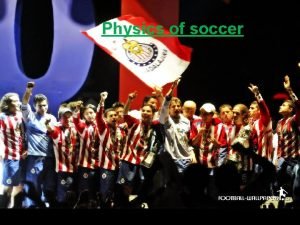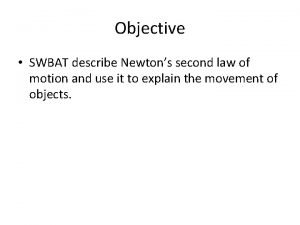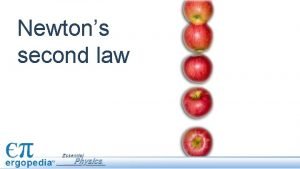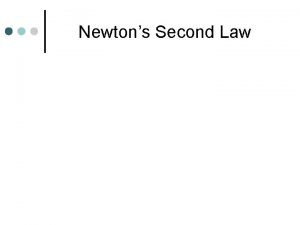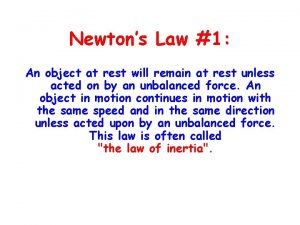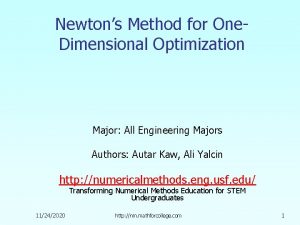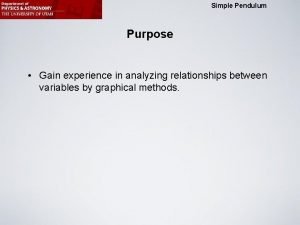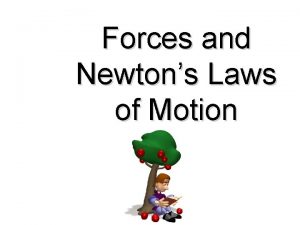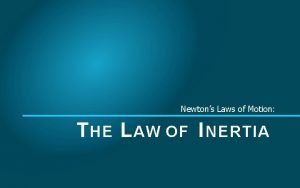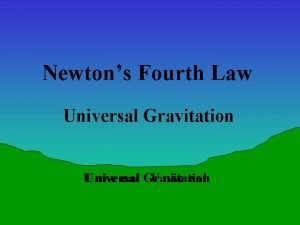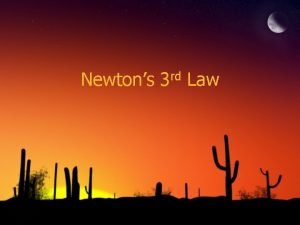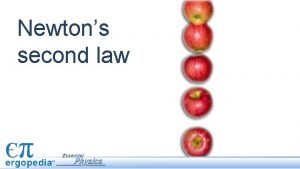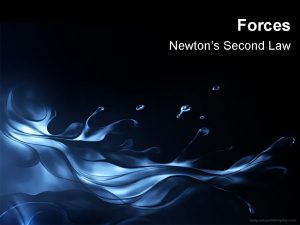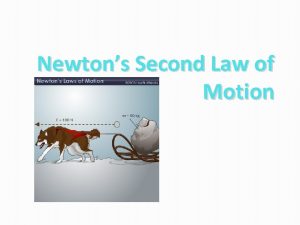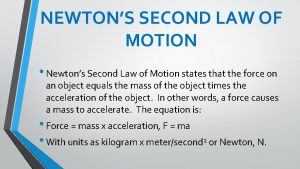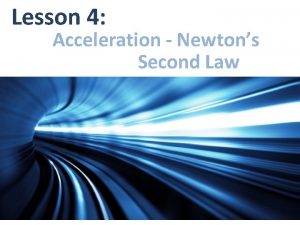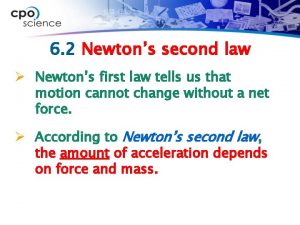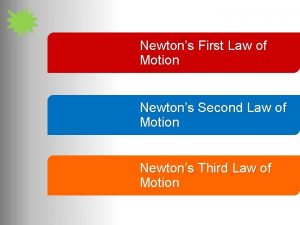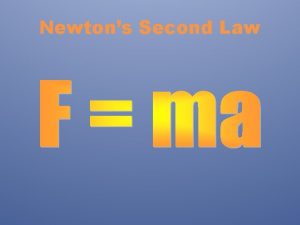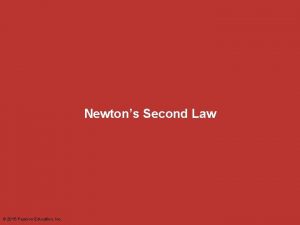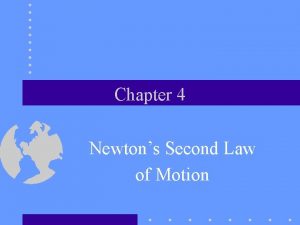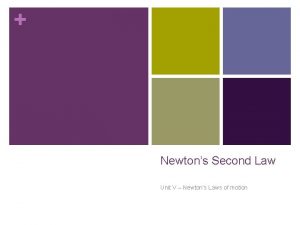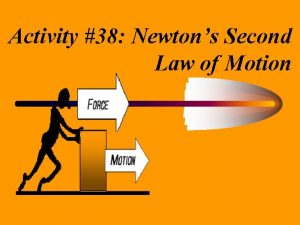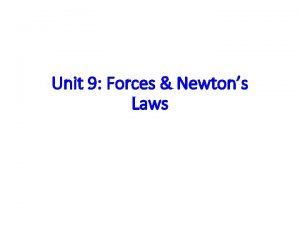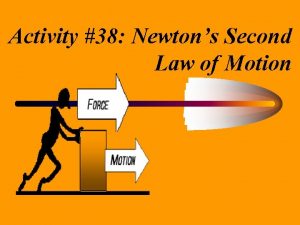Warmup Write a formula for Newtons second law
































- Slides: 32

Warm-up • Write a formula for Newton’s second law. • Identify and describe the quantities in the formula.

Torque and Angular Momentum Vectors of rotation

Objectives • Determine the torque applied by a force about an axis. • Predict an object’s response to a torque. • Calculate an object’s angular momentum.

Question You push on a door. It will open easiest if you push A. opposite the hinge. B. at the center of the door. C. Next to the hinge.

Torque Turning influence = torque = radius force =r F Units: Nm (not J)

Vector Cross Product • • Operation symbol Another way to multiply two vectors Product is a vector! Direction of A B is perpendicular to both A and B

Cross Product Magnitude a q A B = ab sin q A B b Maximum for q = 90° Zero for q = 0°, 180°

Magnitude Geometrically a q A B b A B = area of parallelogram

Cross Product Direction a q A B b • Curl right-hand fingers in direction of q • Right-hand thumb points in direction of crossproduct • Not commutative A B = –(B A)

Radius Vector • Radius from reference point to application of force • Strictly, reference point must be specified to determine a torque (about the point) • Torque depends on your choice of point!

Adding Torques 750 N • Net torque about fulcrum is zero here • Torques are vectors

Whiteboard Work A 10, 000 -N truck is stalled 1/4 of the way across a 100 -m bridge. What torque does its weight apply about the far (right) support? r

Whiteboard Work What upward force must the near (left) support provide to cancel the truck’s torque about the far support? r F

Whiteboard Work What upward force must the far support provide to support the weight of the truck? Hint: Several ways will work: • canceling forces on the bridge • canceling torques about the near support r F

Lever Arm Component of r perpendicular to F L = r sinq q r F r F = area of parallelogram = LF = area of rectangle

Group Question Force P is applied to one end of a lever of length L. What is the magnitude of the torque about point A at the other end? A. PL sin q. B. PL cos q. C. PL tan q. D. PL sec q. Source: Young and Freedman, E. PL cot q. Test Your Understanding F. PL csc q. § 10. 1

Center of Gravity • Where weight vector would be applied to duplicate torque of weight • In a uniform gravitational field, same place as center of mass

Angular Momentum • Torque is rotational force • Angular momentum is rotational momentum L=r p • Angular momentum is a vector • Direction by right-hand rule

Units of Angular Momentum L=r p r units = m p units = kg m/s L units = kg m 2/s

Extended Object Angular momentum L = Iw I = moment of inertia – rotational inertia – Rotational analogue of mass • Units (kgm 2/s)/(1/s) = (kgm 2/s)s = kgm 2

I of a Point Mass Iw = r p What is I?

I of an extended object • Add up the I’s of all the masses – Taken about the same axis • Requires calculus for all but the simplest shapes • For a thin hoop or cylindrical shell – Mass M, radius R, about the central axis – I = MR 2

Moments of Inertia Usually expressed in the form I = c. MR 2 c depends on the shape (mass distribution) of the object Formulas for a few shapes are given in Cutnell & Johnson Table 9. 1, on p. 244

Moments of Inertia Source: Young and Freedman, Table 9 -2, p. 291. Your textbook: Table 9. 1, p. 244.

Newton’s Second Law • Force is the rate of change of momentum Dp F= Dt • Torque is the rate of change of angular momentum DL t= Dt

Conservation of Angular Momentum • If no outside torque, L = r p is constant. • If r decreases, p increases!

Question The moon revolves around the Earth with a period of 27. 322 days. If the moon were to move farther away from the Earth but maintain its angular momentum, how would its period adjust? A. Its period would become shorter than 27. 322 days. B. Its period would become longer than 27. 322 days. C. Its period would remain 27. 322 days.

Conservation of Angular Momentum • Nothing can apply a torque to itself. • Any change in one object’s angular momentum is accompanied by an opposite change in another object. • The angular momentum of the universe never changes.

Conservation of Momentum Q. How can linear momentum be conserved if p increases? A. Total linear momentum is zero in a rotating system!

Conservation of Energy Q. What happens to kinetic energy when p increases? A. Kinetic energy increases! DE = w. Work is done to pull rotating parts inward.

Rotational Kinetic Energy • Point mass K = ½ mv 2 • What is this in terms of I and w?

Rotating Kinetic Energy K = 1/2 Iw 2
 Newton's second law in soccer
Newton's second law in soccer Describe newtons second law
Describe newtons second law 2nd law of motion
2nd law of motion 2 law of newton
2 law of newton Newtons second law
Newtons second law Newtons second law example
Newtons second law example Newton's first law and second law and third law
Newton's first law and second law and third law Newton's first law and second law and third law
Newton's first law and second law and third law Newtons second kaw
Newtons second kaw Newtons second kaw
Newtons second kaw Pendulum purpose
Pendulum purpose Newtons third lw
Newtons third lw A girl is suspended motionless from the ceiling by a rope
A girl is suspended motionless from the ceiling by a rope Newtons third aw
Newtons third aw Warmup ratio
Warmup ratio Warmup 65
Warmup 65 Gmass warmup
Gmass warmup Status vs class
Status vs class Surface area warm up
Surface area warm up Mind rhyming words
Mind rhyming words Multiplying with exponents
Multiplying with exponents Java warmup
Java warmup Define:warmup
Define:warmup Pathos story
Pathos story Tinman warm up
Tinman warm up 65 mins
65 mins Warmup end
Warmup end Newtons 3 rd law of motion
Newtons 3 rd law of motion Law of inertia definition
Law of inertia definition Newtons fourth law
Newtons fourth law Newtons 3 rd law of motion
Newtons 3 rd law of motion Newtons 3 rd law
Newtons 3 rd law Newton's 3 law
Newton's 3 law
